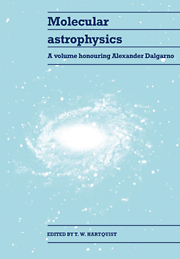Book contents
- Frontmatter
- Contents
- Dedication
- Preface
- Part I Molecular clouds and the distribution of molecules in the Milky Way and other galaxies
- Part II Diffuse molecular clouds
- Part III Quiescent dense clouds
- 6 Chemical modelling of quiescent dense interstellar clouds
- 7 Interstellar grain chemistry
- 8 Large molecules and small grains in astrophysics
- Part IV Studies of molecular processes
- Part V Atomic species in dense clouds
- Part VI H2 in regions of massive star formation
- Part VII Molecules near stars and in stellar ejecta
- Part VIII Moderately ionized gas and chemistry at large redshifts
- Index
7 - Interstellar grain chemistry
Published online by Cambridge University Press: 10 December 2009
- Frontmatter
- Contents
- Dedication
- Preface
- Part I Molecular clouds and the distribution of molecules in the Milky Way and other galaxies
- Part II Diffuse molecular clouds
- Part III Quiescent dense clouds
- 6 Chemical modelling of quiescent dense interstellar clouds
- 7 Interstellar grain chemistry
- 8 Large molecules and small grains in astrophysics
- Part IV Studies of molecular processes
- Part V Atomic species in dense clouds
- Part VI H2 in regions of massive star formation
- Part VII Molecules near stars and in stellar ejecta
- Part VIII Moderately ionized gas and chemistry at large redshifts
- Index
Summary
Introduction
The subject of this article is dust in dense interstellar clouds – its composition and its chemical evolution. The relevant astronomical data include extinction and polarization in the infrared, visible and ultraviolet spectral ranges. Identification of the carriers of the observed spectral features is a non-trivial task. The features appear to be notoriously non-unique; significant fractions of them have been assigned to two or more dissimilar materials. Also, it now appears that grains are made largely of highly disordered and/or composite materials. In disordered mixtures spectral features of molecules can be altered considerably with respect to known spectra of pure crystalline materials, which also complicates the identification.
Clearly, additional sources of information are needed. The sources which I chose to employ are the recently available data on the composition of Halley's comet, and on the structure, the composition and the spectral properties of the interplanetary dust particles (IDPs). I thus assume that cometary and IDP materials preserve many of the characteristics of the dust in the original interstellar cloud. As a rationale I quote a recent review of Geiss (1987) on the results of exploration of Halley's comet: (a)‘… The abundance data show that a large fraction of material in Halley's nucleus condensed at very low temperature’ (b)‘… comets are regular members of the solar system which have preserved the original charactistics of the condensed and accreted matter better than other bodies in this system.’
- Type
- Chapter
- Information
- Molecular AstrophysicsA Volume Honouring Alexander Dalgarno, pp. 132 - 147Publisher: Cambridge University PressPrint publication year: 1990
- 3
- Cited by

